|
< Earlier Kibitzing · PAGE 5 OF 5 ·
Later Kibitzing> |
Mar-23-17
 | | keypusher: Part I
Keres wrote an introduction to each round. Here is what he said in his discussion of Round 10. <The most interesting game in the final round of the second cycle was the one between Botvinnik and Keres. Because in the event of a win by Keres, Botvinnik’s lead would be caught up by the end of the Hague-part of the tournament. Black played an original line in the Nimzo-Indian Defence, thus preventing Botvinnik from choosing his favorite variation. But in the middlegame Black incorrectly started to generate activity on the queenside, and thereby opened up a strong diagonal for White’s dark-squared bishop. After this, White threatened to initiate a strong kingside attack. In the case of resourceful defence, Black would still have obtained adequate defensive chances, but on the 16th move he made a blunder that allowed White’s rook to come into play with the win of a tempo, and Black subsequently faced a devastating attack. With a beautiful rook sacrifice, Botvinnik created a mating net around the enemy king, whereupon Black resigned on the 23rd move.> Notes to the game
After 4.e2-e3
<Botvinnik exclusively employs this modest way, which grandmaster Rubinstein recommended, of playing against the Nimzo-Indian Defence, and he has achieved very good results with this line. The advantage with this system of development is that White abstains from unnecessary complications in favor of a solid position where Black is forced to play quite accurately and carefully to keep the balance.> 4….0-0
<Here Black has a wide variety of systems of development that give rise to very different types of positions. The text-move is one of the more elastic, and Black keeps the choice open regarding his further plan of campaign.> 5.a2-a3 Bb4xc3+ 6.b2xc3 Rf8-e8
<6….d5 7.cxd5 exd5 8.Bd3 followed by Ne2 is a standard continuation, and thus generally known. Therefore Black tries to develop along new paths. Also interesting is the idea to play 6….c5 followed by …b6, …Nc6, …Ba6 and …Ne8, which was utilized by Reshevsky against Botvinnik some rounds later. With this method of play, Black commences an attack against White’s pawn weakness on c4 and at the same time …Ne8 protects his kingside against eventual attacks.> 
click for larger view7.Ng1-e2
<White can no longer utilize the normal system of development by 7.Bd3, as it would be met by 7….e5 8.Ne2 e4 9.Bc2 b6 and Black gains strong pressure against the c4-pawn. With the text-move White chooses another move order, but it likewise fails to bring him any success.> The position after 5.a3 is not particularly common (141 examples in the database) and Keres’ continuation is vanishingly rare. But Shredder shares Keres’ positive evaluation of his novel idea. Tolush and his pupil Spassky both tried 7.Bd3 e5 8.Ne2 e4 9.Bb1 and won wild and woolly games: Tolush vs Byvshev, 1952 Spassky vs G Uusi, 1958 But Shredder thought Black was more than OK in the opening in both cases. It also agrees with Keres that he is doing fine (at first) against Botvinnik’s more modest continuation. |
|
Mar-23-17
 | | keypusher: Part II
7….e6-e5 8.Ne2-g3 d7-d6
<Another interesting continuation for Black was 8….d5, in an attempt to open the position and utilize his small edge in development. Also 8….e4 9.Be2 b6 followed by ….Bb7 and taking control over the e4-point merited consideration.> Shredder’s favorite is 8….b6. After running for hours it comes up with 9.f3 Nc6 10.e4 Ba6 and evaluates the position at +0.09. After Keres’ suggestion 8….d5 it plays 9.Be2 dxc4 10.Bxc4 Be6 11.Bxe6 Rxe6 12.0-0 Nc6 13.Bb2 Na5 14.Qe2 exd4 15.cxd4 c6 16.Bc3 Nd5 17.Bxa5 Qxa5 18.Rfb1 +0.22. After the text-move it continues 9.f3 b6 10.e4 Nc6 11.Be3 Na5 12.Bd3 d5, 0.00. After Botvinnik’s 9.Be2 Shredder thinks Black is infinitesimally better. You’re not likely to see 4.e3 0-0 5.a3 — this is the only time Botvinnik played it in a serious game — but if you do, Keres’ idea looks pretty good. Unfortunately, Keres doesn’t make another good move for the rest of the game…. 9.Bf1-e2
<This restrained bishop development is likewise forced; 9.Bd3 would enable Black to win a tempo by 9….e4. Owing to the modest development of White’s pieces, Blackk hardly has any opening problems.> 9….Nb8-d7
<Without any kind of need, Black chooses a relatively passive way of development and thus lets his adversary get away from many problems. The normal continuation 9….c5 10.0-0 Nc6 exerts pressure against the d4-pawn and thus obstructs the e3-e4 advance. Also 9….Nc6 10.0-0 Na5 deserved attention, when Black plans to take advantage against the c4-pawn.> As we’ve seen, Shredder likes …b6, …Nc6, and …Ba6. It thinks White is a little better after 9…c5 10.0-0 Nc6 11.d5 and e3-e4, about the same as it feels about 9….Nb8-d7. 10.0-0 c7-c5
<Suddenly Black shows activity again, and tries to generate a risky attack against the c4-pawn. This opens up the position and thus noticeably increases the power of White’s bishop pair. If Black did not want to play 10….e4 (11.f3 b6 12.fxe4 Bb7) at this point and thus eliminate the tension in the centre, then he could proceed with either 10….b6 or 10….Nf8. This would yield him a solid position without weaknesses where White would not find it so easy to utilize his pawn centre.> 11.f2-f3 c5xd4?
<With this exchange Black hopes to gain sufficient counterplay against the c4-pawn, but this plan is inacccurate and puts Black in great difficulties when the position opens up. After the natural move 11….Nf8 Black’s position would be thoroughly good, because the e3-e4 advance would always be risky for White owing to the reply …Ne6, taking control of the squares f4 and d4.> |
|
Mar-23-17
 | | keypusher: 12.c3xd4 Nd7-b6?
<Black proceeds with his inaccurate plan and quickly becomes worse. The correct continuation was still 12….Nf8, and despite the previous exchange would have given Black a satisfactory position. 12….b6 would also have been stronger than the text-move. It is surprising that Black puts his knight on b6, where it is very badly placed and subsequently does not let Black coordinate his pieces.> 13.Bc1-b2 e5xd4
<Black has nothing better, since White simply threatened to play e3-e4 followed by f3-f4 with a strong attack. For example: 13….Be6 14.d5 Bc8 15.f4 and Black’s position is on the brink of collapse.> In Keres’ line Shredder keeps oscillating between 15….Bd7 and 15….Nbd7, with an evaluation of about +0.5. Incidentally, Shredder thought 13.e4 was stronger than Botvinnik’s move. 
click for larger view14.e3-e4!
<Naturally not 14.exd4 d5 and Black suddenly has an excellent position; Black would also be given some counterplay after 14.Qxd4 Na4 15.Bc1 Qb6 as well as after 14.Bxd4 d5 15.c5 Nc4. After the strong text-move, Black’s position is already very difficult and it is unlikely that he still has the possibility to equalize, even in the case of the best defence.> 14….Bc8-e6 15.Ra1-c1
<Naturally not 15.Qxd4 Na4 16.Bc1 Qb6 and Black can defend himself quite well in the endgame. The text-move opens up the a1-square for the bishop, so that White no longer has to calculate about the threat of ….Na4.> 15….Re8-e7?
<It is amazing how many weak moves Black is able to make in such a short time span. With the text-move he later plans to play ….Ne8, but this whole idea is completely useless.It was necessary to proceed along the paths of the initial plan and play 15….Rc8 16.Qxd4 and now not 16….Rc6 17.f4 Qc7? 18.Nh5!, but 16….Na4 17.Ba1 Nc5 and Black has at least placed one of his pieces in a favourable position. In this case Black would still have prospects of defending his battered position; however, now White’s attack achieves a dangerous strength.> After 15….Rc8 16.Qxd4
16.Qd1xd4 Qd8-c7??
<With this move Black crowns his series of mistakes and loses the game within a few moves. The initially planned 16….Ne8 was also bad in view of the maneuver 17.Nh5 f6 18.Nf4 and White takes control of the important d5-square, but 16….Na4 (Also 16….Rc7 17.Rfd1 Qc8 comes into consideration.) 17.Ba1 Nc5 still offered Black chances of a stubborn resistance.With the text-move Black intends to play an eventual …Qc5, but he completely forgets about the possibility of 17.c4-c5 and now ends up in a lost position.> |
|
Mar-23-17
 | | keypusher: Part IV
17.c4-c5!
<Naturally White utilizes the chance to open up new lines with gain of tempo. Black now falls under a mating attack.> Interestingly, Shredder prefers 17.f4 Qc5 18.Qxc5 19.dxc5 and now either 20.Bxf6 gxf6 21.Nh5 f5 22.Nf6+ or 20.e5 Ne8 21.f5 Bd7 22.Bg4 seem to provide White with a winning positional advantage. But 17.c5 is also obviously quite strong. 17….d6xc5 18.Rc1xc5 Qc7-f4?
<Black could still put up some resistance by 18….Qd8, since the endgame after 19.Qxd8+ Rxd8 20.Bxf6 gxf6 21.Nh5 Rd2 gives him adequate counterplay and on 19.Qe3 there could follow Nfd7 and Black’s defensive resources are by no means over yet. After the text-move Black loses by force.> Shredder rates White about a pawn up after 18….Qd8 19.Qb4 Ne8 20.f4, which is certainly a better score than it gives the game continuation. 19.Bb2-c1
A huge improvement is 19.Bb5, clearing e2 for the knight, hitting the d7 square (where a knight could support the knight on f6) and threatening to bring the rook to g5. Black has no defense, e.g.. 19….a6 20.Ne2 Qb8 21.Rg5 threatening both Qxf6 and Rxg7, or 19….Bd7 20.Nf5 Bxf5 21.Rxf5 Qh4 22.Bc1 h6 23.Be3 Rd7 24.Qb2, etc.; or 19.Nbd7 20.Ne2 Qb8 21.Rg5 Qf8 22.Bxd7  19…..Qf4-b8
<Or 19….Rd7 20.Qb4 Qb8 21.Bb5 Rd8 22.Bg5 and Black can resign.> After 22…..Nbd7 Black need not do anything so drastic. Stronger than 21.Bb5 in Keres’ line is 21.f4 or 21.Be3, but Black needn’t resign after that move either. Botvinnik definitely gave Black a chance to stay alive with 19.Bc1, but Keres did not take advantage. 20.Rc5-g5 Nb6-d7
<Losing on the spot, but 20…Ne8 21.Nh5 f6 22.Nxf6+ Nxf6 23.Qxf6 could only prolong the final result, and no longer change it.> 
click for larger view21.Rg5xg7+!
<This beautiful sacrifice, which is easily seen, is the simplest road to victory. Black can no longer escape from the mating net.> 21….Kg8xg7 22.Ng3-h5+ Kg7-g6
<Or 22…..Kh8 23.Bg5, or also 22….Kf8 23.Nxf6, and Black has no defense.> 23.Qd4-e3
<23.f4 would also have won, but the text-move is quicker.> <Black resigned.
Definitely my weakest game of the tournament. However, Botvinnik vigorously utilized the chances he was offered, and convincingly demonstrated the power of the bishop pair in an open position.> Not much to say except that Keres played terribly. Badly enough to prove a fix? Of course not; but very few games are bad enough for that. |
|
| May-10-21 | | N.O.F. NAJDORF: <Botvinnik vigorously utilized the chances he was offered> The question is: why was he offered them?
What on earth could be the purpose of 15... Re7? If the purpose was to play 16 ... Rc7, why did he play 16 ... Qc7 instead? And why not just play ... Rc8, rather than ... Re7, followed by ... Rc7? If the purpose was to play 16 ... Qe8, why didn't he? Is it really believable that a player of Keres' strength could not foresee 17 c5 in reply to 16 ... Qc7? The moves 15 ... Re7 and 16 ... Qc7 seems to be contrived to facilitate an attack on the black king reminiscent of a game played by Botvinnik against Capablanca ten years earlier in a tournament which Keres had won! In both games, black's king is on g7 and knight on f6 and white plays Nh5+. Is it really believable that Keres didn't remember the combination, even though it occurred in what was arguably his best-ever tournament? Botvinnik vs Capablanca, 1938 |
|
| May-10-21 | | N.O.F. NAJDORF: Another question that occurs to me is:
why did black play the suicidal 18 ... Qf4,
when he could have played 18 ... Qd8 ? |
|
May-10-21
 | | perfidious: <keypusher> suggests this as an improvement in his notes from his last post, on 23rd March 2017. |
|
May-10-21
 | | keypusher: < N.O.F. NAJDORF: Another question that occurs to me is:
why did black play the suicidal 18 ... Qf4,
when he could have played 18 ... Qd8 ?> Probably in hopes of inducing Botvinnik to pull the bishop off the long diagonal, which worked. If Keres had interpolated 19....Rd7 before retreating the queen (if 20.Qxd7?? Nbxd7 White's advantage is pretty much gone), he still would have been in the game. Much stronger that 19.Bc1 was 19.Bb5, but neither Botvinnik nor Keres saw that. <The moves 15 ... Re7 and 16 ... Qc7 seems to be contrived to facilitate an attack on the black king reminiscent of a game played by Botvinnik against Capablanca ten years earlier in a tournament which Keres had won!In both games, black's king is on g7 and knight on f6 and white plays Nh5+. Is it really believable that Keres didn't remember the combination, even though it occurred in what was arguably his best-ever tournament?> Yes, of course it is. You're being silly. Botvinnik-Capablanca was one of the most famous games of the 1930s, so I’m sure Keres would have been familiar with it no matter where it had been played. The positions in the Capablanca and Keres games aren't even that similar, but the basic motif of taking advantage of a pinned knight with a knight check is pretty common. So what? At the beginning of every week on this website we see grandmasters falling into simple combinations featuring themes they've doubtless seen any number of times. There are quite a number of posts on this game page on the theme "how could Keres possibly play this badly? It must have been fixed!” Well, maybe it was, but the fact is grandmasters (including Keres and Botvinnik!) play like this sometimes. I gathered examples in response to Maxi saying pretty much exactly what you’re saying now back in 2008. Botvinnik vs Keres, 1948 (kibitz #63) And here’s Keres having another terrible day against Botvinnik. Botvinnik vs Keres, 1966 |
|
| Mar-19-22 | | cehertan: Blacks 11th move isn�t really in the spirit of this opening. If it wasn�t fixed, Keres again prepared badly for his nemesis. The final combo is pretty, but Childs play for super-GMs. |
|
| Mar-20-22 | | SChesshevsky: <...the fact is grandmasters (including Keres and Botvinnik!) play like this sometimes...) Yeah, they can all have clunkers but this one is embarrassingly bad. The biggest sins for these guys are often: losing tempo, lack of mobility, and illogical moves. Painful to even see, forget about playing, for top GM's. Here Keres seems to commit them all starting move 15...Re7. And that still might be forgivable if it results in at least some sort of hail-mary attack counter play. But here... I don't know why Keres played this lemon. But it is extremely rare that GM's play such a series of unprovoked unprincipled moves, without an apparent plan, and end up in such a passive position. Important not to mix up a bad result with bad chess. Even if Keres could draw this somehow, moves like...Re7 ...Qc7...Qf4 is just bad chess. It's even very rare for GM's to let themselves play this ugly. Once they sense they've gone badly wrong, they usually even resort to some kind of desperate counter play before being subject to what amounts to painful positional suicide. |
|
| Oct-08-22 | | Synchsynch: I understand that Bronstein, and others, have admitted Soviet fixes. I remember a long time ago, I played through a game of Botvinnik Vs Keres, forget which one now, and saw Keres go for an ending where he had 5 pawn islands. It looked a clear case to me that he had done this deliberately, intending to lose. Botvinnik did complain apparently very much, at some point in time, when he found out things were being "arranged", he definitely wanted to win by merit. |
|
Jan-04-24
 | | plang: 6..Re8 was new and is very rarely played nowadays but is a perfectly reasonable move. 9..Nbd7?! seems a bit passive; the queen knight is usually developed on c6 in the Samisch where it pressures d4 and sometimes goes to a5 hitting c4. Botvinnik on 11..cxd?:
"Hardly a useful decision in the given position as White's QB now comes to life, and the doubled pawn is dissolved away." Black must have overlooked 14 e4!. 16..Qc7? is a puzzler; it is rarely good to place the queen opposite an opponent's rook. |
|
Feb-17-24
 | | KEG: A fine performance by Botvinnik overwhelmed one of the worst games I have ever seen Keres play. The result here left Botvinnik in the driver's seat in this world championship tournament. Before this game, Botvinnik was 5-2 while Keres was 4-3. This win put Botvinnik two points ahead of Keres and Smyslov and 1.5 points ahead of Reshevsky (who was lucky to achieve a draw from a piece down ending against the hapless Euwe). Much ink has been spilled concerning whether the fix was in and Keres threw this game so Botvinnik would win the title. Beyond saying that I have never found this theory convincing, I am not going to devote time to this overblown debate. I find the remarks on this subject by <keypusher> to be a superior version of what I might have contributed on this topic. As of 1948, Botvinnik was almost certainly the strongest player in the world. He had never lost to Keres in eight prior meetings. True, his four consecutive wins against Keres in this event must have been astonishing. But there is little reason to question that--with or without interference--Botvinnik was a heavy favorite. He finished 3.5 points ahead of Keres in this tournament, and could surely have been further ahead had he not yielded draws to Euwe in the final two laps while Euwe--who finished in last place with a 4-16 record lost every game to everybody else. The above being said, as a fan of the great Paul Keres, I did not much enjoy watching Keres get beaten to a pulp here while he played what he rightly called "my weakest game in the tournament." Having said the above, I turn now to the game itself: 1. d4 Nf6
2. c4 e6
3. Nc3 Bb4
4. e3 0-0
5. a3
Employing a variation against the Nimzo-Indian similar to that he played against Keres at AVRO 1938. Whatever the theoretical merits of the move, Botvinnik had enjoyed fine results when he played it. Keres must have anticipated that Botvinnik would try it again in this game. 5... BxN+
6. bxB Re8

click for larger viewA novelty at the time. According to Golombek (and Botvinnik), the move "is designed to facilitate d5 and immediate pressure on the e-file." More usual is 6...c5, which might have transposed into the above-mentioned game between these two players at AVRO 1938. 6...d5 was well-known at the time. For this reason, according to Keres, he decided to try to develop along "new paths." The verdict on the text by <plang>, in my opinion, is on the money: "...new and..very rarely played nowadays but is a perfectly reasonable move." Whatever the ultimate decision on the merits of 6...Re8, Keres got an entirely reasonable game out of the opening and through at least move 8 was certainly not worse. 7. Ne2
"A good maneuver to contest control of the squares e4 and f5." (Golombek) "White can no longer utilize the normal system of development by 7. Bd3, as it would be met by 7...e5 8. Ne2 [8. dxe5 is surely a better choice for White here--KEG] e4 9. Bc2 b6 and Black gains strong pressure against the c4-pawn. With the text-move White chooses another move order, but it likewise fails to bring him any success." (Keres) 7... e5
All according to plan. To this point, Keres appears to have achieved his objective on the e-file: 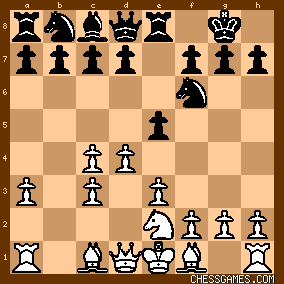
click for larger view8. Ng3 d6
Keres suggested 8...d5 or 8...e4 as alternatives, but neither of those moves would create problems for White. If 8...d5, Black--in spite of having created an isolated White c-pawn, gets an awkward position after 9. dxe5 Rxe5 10. cxd5 Qxd5 11. Bb2. I give a small edge to White here. And if instead 8...e4, White is fine after 9. f3. Surely the best choices for Black here were 8...Nc6 or 8...b6. The text, however, seems to yield an entirely decent position for Black. 9. Be2
As both Keres and Golombek pointed out, 9. Bd3 would favor Black after the inevitable 9...e4. 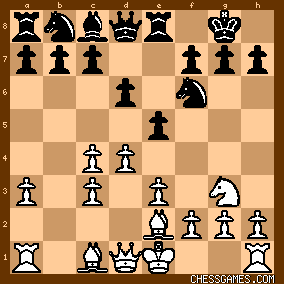
click for larger viewAs Keres aptly summed up:
"Owing to the modest development of White's pieces, Black hardly has any opening problems." |
|
Feb-18-24
 | | KEG: Post II
9... Nbd7
"?!?--<plang>
So far as I can determine, this is the only time this move has been played here. It is the first of the moves by Keres questioned by the commentators: "The first ominous sign of an anti-positional virus that seems to affect Black throughout the remainder of this game. The Knight is ineffective on this square, and should be reserved for c6, whence it can eventually attack the doubled pawn by Na5. " (Golombek) "On this square the Knight interferes with the Bishop." (Kmoch) "...One should keep in mind that White acquired the Bishop pair and control of the center in the opening, which means that it is up to Black to create compensation for this. To this end, Black must exploit his lead in development and White's doubled c pawns." (Euwe) "Without any kind of need, Black chooses a relatively passive way of development and this lets his adversary get away from many problems." (Keres) "...seems a bit passive; the queen knight is usually developed on c6 in the Samisch where it pressures d4 and sometimes goes to a4 hitting c4." (<plang>) I agree that 9...Nc6 is superior and probably best, but the text--a common manner of developing the b8 Knight in closed games--is hardly any sort of serious mistake and does not explain the catastrophe that would soon befall Keres here. 9...c5, recommended by many of the commentators (including Golombek, Keres, and Botvinnik himelf), leaves White better after 10. 0-0 Nc6 11. d5. After 9...Nc6, Black has whatever edge there is. 10. 0-0
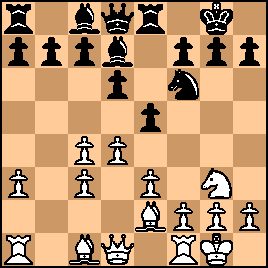
click for larger view10... c5
This effort was criticized by several commentators, many of whom, fresh from trashing Keres' ninth move as overly passive, now fault him for undue aggression: "...this move clashes with his ninth." (Golombek) "This system hardly constitutes any threat to the doubled pawns." (Kmich) "Suddenly Black shows activity again, and tries to generate a risky attack against the c4-pawn. This opens up the position and thus noticeably increases the power of White's Bishop pair." (Keres) Many of the commentators opt for 10...e4, and that does appear to be an improvement. But, yet again, the text is hardly any kind of dreadful positional or tactical mistake, and the beating up of Keres' play to this point strikes me as the worst sort of Monday-morning quarterbacking (much akin to the crazed bashing of Kyle Shanahan for taking the ball first in overtime [which was obviously correct] and then kicking the field goal [a close call in my book]. Keres does soon enough lose his way in this game, but not yet. 11. f3
"!"--(Botvinnik)
"The awkward placing of the Knight on d7 now begins to tell. White gets the chance to advance his e-pawn as [the d4] square is not under attack." (Botvinnik) While the text is perhaps best here, it is no sort of brilliancy warranting a "!" and Black's position--while somewhat inferior--is not all that terrible: 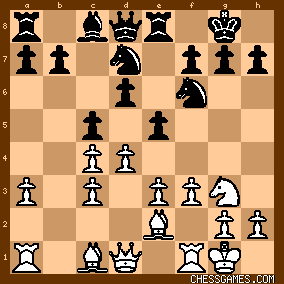
click for larger view11... cxd4
"?"--(Golombek)(Kmoch)(Keres)(<plang>) "...a poor move that opens the game to his own detriment." (Golombek) "...very bad here for there is no counter-pressure on the c-file. The opening of lines only brings grist to White's mill. Keres must have made a grave error in calculation; there is no other explanation for his elementary failure in this game." (Kmoch) "This move solves the problem of White's doubled pawns." (Euwe) "With this exchange Black hopes to gain sufficient counterplay against the c4-pawn, but this plan is inaccurate and puts Black in great difficulties when the position opens up." (Keres) "Hardly a useful decision in the given position, as White's c1 Bishop now comes to life and the doubled pawn is dissolved away." (Botvinnik) The text was indeed poor, but frequently made this exchange in the Nimzo-Indian, most notably in his game as Black against Botvinnik at AVRO 1938. The current position, however, differed from the earlier game. 12. cxd4
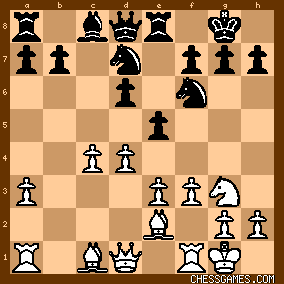
click for larger view |
|
Feb-18-24
 | | beatgiant: <KEG> Although we don't find other games with 9...Nbd7 in our database, we do find two others that transpose back to the position in this game after 9...c5 10. 0-0 Nbd7: C Niklasson vs E Mortensen, 1979 (White won) and I Sokolov vs T Luther, 1991 (drawn). |
|
Feb-19-24
 | | KEG: <beatgiant> Thank you. I was unaware of those games. Nonetheless, these contests from 1979 and 1991 do not alter the novelty that Keres attempted. One wonders how the move might have been assessed had Keres played the balance of the game at his usual high level instead of what actually transpired. |
|
Feb-19-24
 | | KEG: Post III
12... Nb6
"?"--(Keres)
Though not necessarily catastrophic, this move was rightly deemed inferior by the commentators: "...not a very fortunate decision." (Euwe)
"Black proceeds with his inaccurate plan and quickly becomes worse." (Keres) In fairness, and as Golombek aptly noted, Black already had an inferior position and thus had no entirely satisfactory choices. If instead 12...d5, then White takes control with Golombek's 13. Bb2 (much better than Euwe's proposed 13. c5). And if 12...exd4 then White gets excellent winning prospects with Euwe's 13. Qxd4 (much better than Golombek's suggested 13. exd4 which would allow Black to respond with 13...d5). But Euwe, having found the best line against 12...exd4 (13. Qxd4) then mistakenly concludes that Black would now have been fine with 13...Qb6, which in fact would not have been all that great for Black after 14 Rd1. Best play for Black here would have been 12...Nf8 (actually putting this Knight to use) as proposed by Golombek and Keres. Other decent--but far from completely satisfactory options--include Keres' alternate 12...b6 and perhaps the ugly-looking 12...Nb8 (which was not mentioned by anybody. After Keres' 12...Nb6, the position was:
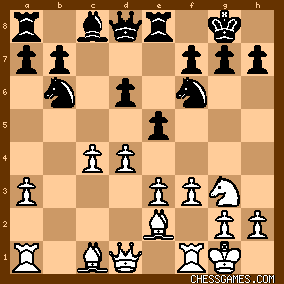
click for larger viewIn fact, Botvinnik did not immediately take advantage of Keres' weak 12th move: 13. Bb2
As only <keypusher> seems to have noticed, much better was 13. e4 immediately, after which Black would face an onerous task to try to hold the game. After the text, Keres had a chance to solve many of his problems. But here Keres erred with: 13... exd4
This was hardly best, but it was not the bring on the apocalypse as many commentators have opined: "?'--(Golombek)(Euwe)
"Positional suicide; this further opening up of the game is almost incomprehensibly weak." (Golombek) "An obvious oversight---Black was counting on 14. exd4 d5!" (Botvinnik) "...really bad." (<RookFile>) But Keres' move did have a certain logic, as <euripides> has noted: "...gives up the e5 pawn, probably with the very normal idea of supporting d5 later. It fails because of the specific idea e4." Indeed, Keres himself stated that "Black has nothing better. White simply threatened to play e4 followed by f4 with a strong attack." Almost certainly 13...Be6 was best here, as was recognized by Golombek and Euwe. Keres claimed that 13...Be6 was inadequate in light of 14. d5 Bc8 15. f4. But then Black seems to be not so bad after 14...Nbd7 or perhaps even 14...Bd7. And if instead White played Golombek's suggested 14. dxe5 Black seems not so awful with 14...dxe5 15. QxQ RaxQ 16. Bxe5 and now 16...Bxc4 instead of Golombek's weaker 16...Nxc4. After Keres' actual 13...exf4, the position was: 
click for larger viewHere, Botvinnik played the universally acclaimed: 14. e4
"!"--(Golombek)(Kmoch)(Euwe)(Keres)(Botvinnik)
"In great contrast to Black, Botvinnik's play is a model of vigour and accuracy. He once and for all prevents Black's d5 (which would come after 14. exd4) and avoids the possible freeing of Black's game." (Golombek) "Now White takes full control of the proceedings." (Euwe) But was this actually best? And is Black truly dead after the text? I think not. I prefer 14. Qxd4 which Keres dismissed in light of 14...Na4. But White still then has a grip on the position after 15. Bc1. Also seemingly superior to the text was 14. Bxd4. Keres disliked this move in light of 14...d5, but then White truly takes charge with 15. c5 and then if Black plays 15...Nc4 (Keres' idea, I think 15...Nbd7 might be a small improvement) then White has excellent winning chances with 16. e4. As for the true strength of the much lauded 14. e4, I will consider the consequences in my next post, the position now being: 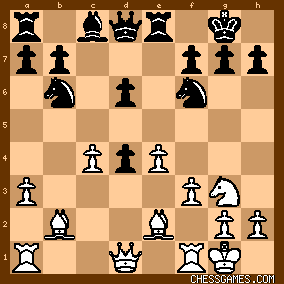
click for larger viewAs I will attempt to show, Keres lost this game (i.e., got blown off the board in short order) because of his poor ensuing play and not because he was anywhere near lost at this point. |
|
Feb-20-24
 | | KEG: Post IV
14... Be6
Keres shortly afterwards got into time trouble (which would have been strange if the game were truly rigged), but at this point the clocks stood: Botvinnik: 1:15
Keres: 1:05
15. Rc1
"!"--(Kmoch)
"With the double purpose of centralizing the Rook...and also of giving the [b2 Bishop] a square of retreat if eventually attacked by ...Na4." (Golombek) "The text-move opens up the a1 square for the Bishop so that White no longer has to calculate about the threat...Na4." (Keres) Much of the discussion of this move by the contemporary commentators consisted of trashing the alternate move: 15. Qxd4. Keres, for example gives the line 15. Qxd4 Na4 16. Bc1 Qb6. But then White just plays 17. Rd1 with a position at least as good as what he got in the game. In any case, 15. Rc1 left:

click for larger viewThus far, I do not find Keres' play all that bad at all. But now, whether because he was frustrated by his inability to obtain a superior position after his innovative opening strategy, Keres began to play as if in a fog, and was quickly slaughtered: 15... Re7?
"?"--(Keres)
"Passive play." (Botvinnik)
"...He intends to play ...Ne8, but the whole idea is completely useless." (Keres) As most of the commentators noted, 15...Rc8 would have been much better. Play might then have proceeded: 16. Qxd4 Na4 [Golombek's alternate line 16...Qc7 17 Rfd1 was not as good, and his next suggestion---17...Nc4 (17...Na4 likely still holds the game) would have been a massive blunder which would have gotten crushed by 18. BxN BxB 19. Nf5! with a crushing attack] 17, Ba1 Nc5 after which Keres said that "Black would still have had prospects of defending the battered [?!--KEG] position"; and Euwe--more realistically states that there would then be "some slight advantage for White." After the text, Keres was still far from lost, but now the defense would be arduous. 16. Qxd4
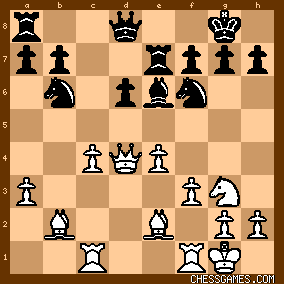
click for larger viewHere, Keres blundered after which he was probably already doomed: 16... Qc7
"?"--(Golombek)(Kmoch)(Euwe)(Kasparov)
"??"--(Keres)
"...this move, with the loss of time involved by the necessity of finding a haven for the Queen, brings about a loss in very quick tempo." (Golombek) "Another mistake"--(Kmoch)
"A serious mistake which hands White all the trumps." (Euwe) "Careless, as the following line opening favors White [because of] his two dangerous Bishops." (Botvinnik) "With this move Black crowns his series of mistakes [quite an overstatement--KEG] and loses the game within a few moves...Black intends to pay an eventual ...Qc5, but he completely forgets about the possibility of 17. c5 and now ends up in a lost position." (Keres) "Allowing a decisive breakthrough" (Kasparov)
There is no doubt that Keres' 16...Qc7 was bad. The more interesting question is what he SHOULD have played. I will address this issue in my next post on this game. |
|
Feb-20-24
 | | KEG: Post V
Euwe, Botvinnik, and Kasparov have all recommended 16...Rc8, but that can't be right. All agree that play would then continue 17. Rfd1 Qc7 18. Qxd6 QxQ 19. RxQ after which Black is in trouble after Euwe's 19...Rec7 20. BxN or after 19...Ne8 (a la Botvinnik and Kasparov) 20. Rd4 [20, Qdd1 may be even better than the Botvinnik/Kasparov move--KEG] and now White is close to winning after either the Botvinnik/Kasparov 20...Rec7 which runs into 21. Nf5 or after 20...Na4 21. Ba1 Rec7 22. Nf5. 16...Ne8 mentioned by Keres is also bad for Black after 17. Nh5; as is his other alternative idea 16...Rc7 after 17. Rfd1 The best chance for Black is clearly 16...Na4, Keres' primary idea, also suggested by Golombek and Kmoch. Play would then continue 17. Ba1 Nc5 with real hope of being able to resist. By contrast, Golombek's suggestion here of 17...Qb6 could be crushed by 18. c5! (Golombek only considered 18. QxQ which leaves White better but not clearly winning. In any case, let's return to the actual game after Keres' 16...Qc7?: 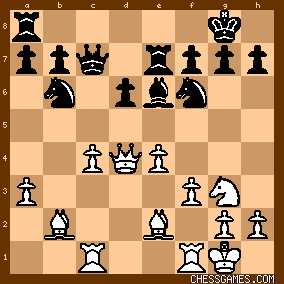
click for larger view17. c5
"!"--(Golombek)(Kmoch)(Euwe)(Keres)(Kasparov)
"Opening all the files and deploying a new and strong piece for the attack" (Euwe) "Naturally White utilizes the chance to open up new lines with gain of tempo. Black now falls under a mating attack." The text is certainly very strong, but perhaps equally good is 17. f4 suggested by <keypusher>. Play might then have continued: 17...Qc5 18. QxQ dxQ 19. BxN gxB 20. Nh5 leaving Black in perilous condition at best. But let's return to the actual game and the culmination of Keres' tragedy: 17... dxc5
18. Rxc5
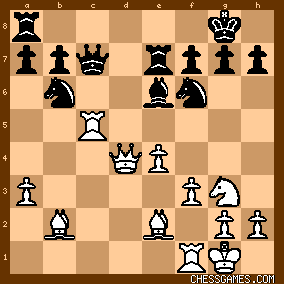
click for larger view18... Qf4?
"?"--(Kmoch)(Keres)(Kasparov)
"Move by move Black chooses the shortest way to defeat." (Kmoch) The text was indeed wretched. But what about 18...Qd8. This move, mocked by Euwe and Botvinnik, was truly the only remaining hope for Black (assuming best play for White). Most of the commentators then assume White would play 19. Qe3. Both Euwe and Botvinnik thought this would be decisive for White. But now, as noted by both Keres and Kasparov, Black would have some hope after 19...Nfd7, and 19...Ne8 might be better still. Also unconvincing is the oft-cited 19. QxQ+ RxQ 20. BxN gxB 21. Nh5. But then Black seems to escape with the overlooked 21...f5. Better for White here is 21. Rfc1, but Black still seems to have some resources. The best winning chance after 18...Qd8 is 19. Qb4! which only <keypusher> appears to have found. (Note: the notes on this game by <keypusher> are so excellent I almost decided not to add my own comments) After 18...Qf4?, Keres did appear to be dead lost: 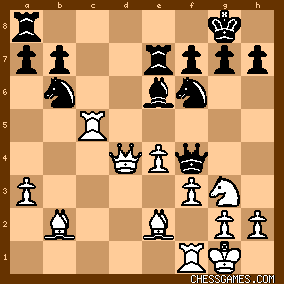
click for larger viewWhite to play and win:
19. Bc1
"!"--(Kmoch)(Kasparov)
In fact, and as only <keypusher> seems to have noticed, the text was actually a mistake which gave Keres a ray of hope. The true killing move here was 19. Bb5! See the analysis of this move by <keypusher> here. My only addition to his commentary is that 19...Rd7 sacrificing the exchange (which White should probably decline) is the best try (albeit likely futile).. BRAVO <keypusher> So now let's consider the position after Botvinnik's actual 19. Bc1: 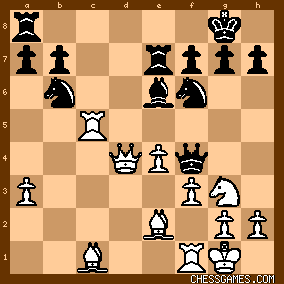
click for larger viewAs I will discuss in my next post on this game, Keres--contrary to everything written on this game other than the commentary by <keypusher> still had a chance to offer meaningful resistance. To quote <keypusher> yet again, "Botvinnik definitely gave Black a chance to stay alive by 19. Bc1, but Keres did not take advantage." More on this in my next post on this game. |
|
Feb-20-24
 | | NM JRousselle: It's difficult to know how to assess these games. Was the "fix" in?
Was Keres told to lose to Botvinnik?
Moves like 11... cd are very surprising coming from a Super GM like Keres. Botvinnik probably needed little/no help to win this event, but maybe this was a case of making sure... Again, difficult to assess. |
|
Feb-21-24
 | | KEG: <NM JRousselle> As a Paul Keres fan, I was dismayed by his play in this game. But I do not believe there is compelling evidence that "the fix was in." As <keypusher> has amply explained, even the finest players have lousy games. With regard to 11...cxd4, this is less surprising than it might appear since Keres frequently played this very move when employing the Nimzo-Indian Defense. As I have pointed out, Keres played ...cxd4 in drawing a Nimzo-Indian Defense against Botvinnik at AVRO 1938. While the position was different here because Keres had introduced a novelty on move 6, I suspect that Keres may have been pre-disposed to play this exchange. I agree with you that Botvinnik needed little or no help to win this event. Keres managed a tie for 3rd/4th place only by stomping on the hapless Euwe (winning four of their five games and drawing the others), while Botvinnik generously gave Euwe three draws. And--in games in which there was clearly no fixing--Botvinnik went plus two against Reshevsky while Keres was minus one against Reshevsky (and needed a miracle in lap 3 to win his single game against Reshevsky). Simply put, and sad to way, Botvinnik was a much better player than Keres in 1948. |
|
Feb-21-24
 | | KEG: Post VI
19... Qb8?
Now the game was certainly gone.
As most of the commentators recognized, 19...Rd7 was much better and just might have given Keres a fighting chance. If then 20. Qf2 (probably best) Keres could have usefully played 20...Qb8 after which play might have continued 21. Bb5 (the only winning chance I can see) Rd8 22. Rg5. This is probably still a won position for White, but nowhere near as catastrophic as Keres' actual move. If instead (after 19...Rd7) 20. Qb4 (as given by several commentators), then Qb8 21. Bb5 (the move suggested by both Keres and Kasparov), then 21...Rd8 and now if 22. Bg5 (Keres' idea, arguably 22. Rg5 is stronger) then Black has reasonable chances to hold after 22...Nfd7 as has been pointed out by <keypusher> To be clear, I am not suggesting that 19...Qd7 saves the day for Black. But, especially over the board, it might have given Keres more than a fighting chance. By contrast, after Keres' actual 19...Qb8, Black is dead, as Botvinnik quickly demonstrated, the position now being: 
click for larger view20. Rg5!
"Threatening 21. QxN(f6)." (Kmoch)
"Threatening all sorts of horrors..." (Golombek) 20... Nbd7?
20...Ne8 is best, but as <keypusher> and others have demonstrated, it would at most have prolonged the struggle without changing the now destined outcome. The text left:
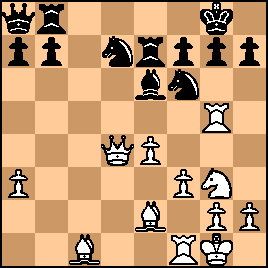
click for larger view21. Rxg7+!
"!"--(Golombek)(Kmoch)(Keres)(Botvinnik)(Kasparov) "Very pretty and completely devastating..." (Golombek) "A beautiful decision." (Euwe)
"This beautiful sacrifice, which is easily seen, is the simplest road to victory. Black can no longer escape from the mating net." (Keres) 21... KxR
There is nothing better.
22. Nh5+
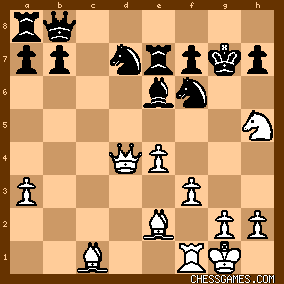
click for larger view22... Kg6
A quick way to end his doom. But 22...Kh8 loses not only to 23 Bg5 as given by <keypusher> but also to 23. f4 and to 23. NxN Qe5 24. Bb2 [cute!] QxQ 25. BxQ Kg7 [what else? 26. NxN+. 23. Qe3
23. f4 as noted by <keypusher> also wins. And 23. Qd2 wins most quickly and effectively. 1-0
The finale showed Botvinnik as his best and must have been a shattering blow to Keres. |
|
Feb-21-24
 | | beatgiant: <KEG> On 19...Rd7, what do you see if White replies <20. Qc3> aiming for an attack similar to the actual game? For example 19...Rd7 20. Qc3 Qb8 21. Rg5 Ne8 22. Nh5 g6 23. Bb2 Kf8 <24. f4>. It's easy for White to find a series of strong attacking moves here. |
|
Feb-21-24
 | | nizmo11: Stockfish shows that after 19...Rd7! if now Qb4 or Qc3 then Black has the reply 20...Qd6. The point is that after 20. Qb4 Qd6 21.e5 does not win a piece because of 21...a5! 22.Qc3?! Qf8! and if 23.exf6 then 23...Na4! (the same after 20.Dc3 Qd6 21.e5 Qf8)
Therefore computer prefers 20.Qf2, and after 20...Qb8 it continues with 21.Bb5 Re7 22.Bg5, and claims that Black has nothing better than 22...Rc7 23.Bf4 Rxc5 24.Bxb8 Rxb5 that should also lose. |
|
Feb-22-24
 | | KEG: I agree with most of the response of <nizmo11> to the query raised by the always clear-thinking <beatgiant> I had not considered 20. Qc3 in response to 19...Rd7, but then 20...Qd6 seems to give Black a fighting chance after 21. Rg5 Ne8 22 Nh5. But--to be fair--Black is still in trouble, even if not theoretically lost. I still think that 20. Qf2 is the strongest line for White after 19...Rd7, but then after 20...Qb8 (seemingly forced) White's strongest line is probably 21. Bb5 (as I said before) is White's best winning attempt. My bottom line remains unchanged (i.e., that 19...Rd7 is best but perhaps not sufficient to save the day, though <beatgiant> and <nizmo11> have given me much to consider. The very least that can be said is that 19...Rd7 is far superior to Keres' actual 19...Qb8. One thing, however, is clear to me from reading the comments of <beatgiant> and <nizmo11>---the position after 19...Rd7 is far more complex and interesting than I had believed and than my commentary reflected. |
|
 |
 |
|
< Earlier Kibitzing · PAGE 5 OF 5 ·
Later Kibitzing> |
|
|
|





